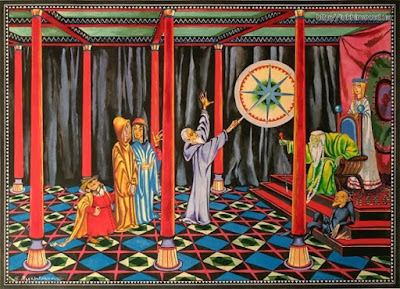Following the guidelines of previous entries, I'm devising some possibilities to simple and cool magic systems.
I want magic progression to follow a 4-step, exponential structure; from non-magical, to initiate, mage and archmage (and diminishing gains after that if any).
Magic, then, is cast from a list of spells that increase in number on every "magical grade", but also in power.
What I have for now is this:
Initiates roll 1d6 when casting spells
Mages roll 2d6
Archmages roll 3d6
and spells have three parameters to be measured:
Impact (how many hp you heal, damage you do, effect you cause, etc)
Range (how many people it affects)
Retain (decides if the spell is retained after use or not)
As I want that there are mechanical benefits to casters to disregard armor, I made it so wearing armor or other encumbrances decreases the chance to retain spells: you must roll your movement rate or under to keep the spell.
Sample movement rates:
No armor=2
Light armor=1
Heavy armor=0
Initiates roll 1d6 to cast magic. So when an initiate rolls a heal spell, the result defines all parameters; but one from impact or range is defaulted to 1:
Lets say he rolls a 4: he can choose to heal a target 4 hit points, or heal 1 hit point to up to four targets. As he rolled over its movement rate (no armor=2), the spell is lost.
Mages roll 2d6 to cast magic. They can allocate the results anywhere they see fit from Impact, Range or Retain. A parameter which has no results is defaulted to 1, and if its Retain, its automatically lost.
Mage in no armor rolls a 4 and a 2 when healing: He can choose, for example, to heal 4 points to a target and keep the spell (2 is equal to his movement rate); or maybe he can heal 2 points to 4 targets and lose the spell.
Archmages roll 3d6 to cast magic. They are, of course, benefited from allocating low rolls on Retain and high rolls on effect.
Archmage in light armor casts heal and rolls 3, 3 and 1. He heals three points to three different targets, and as he keeps the spell, he can attempt it again next turn.
Now the base is established, lets get to the fun spare bits:
* Some spells make no sense in having a numerical score for Impact, but they can be described differently depending on the result assigned to it (from an 1 to 6 score, how much does "Magical Light" shine into the cave?). On others, where the result is a matter of yes or no (charm, sleep, maybe) the Impact roll can measure the number of turns affected, being a threshold that you must reach for the spell having an effect (like in "sleep needs a 3 at least to kick in") or just having the spell work straight, and making it more a matter on "how many people you sleep" (effectivelly putting the weight on the Range score)
* Mages and Archmages revert to 1d6 lower if they are for any reason deprived from their magical wands (I'm a great fan of Earthsea novels)
* Spells can be learned multiple times. This is the way in which a forest nymph (Initiate level) would cast Entangling vines many times before retreating.
* Things that complicate this structure further must be treated on a case by case basis, described on the specific spell description.
* Casters can attempt to cast spells reactivelly: when they are attacked, they can attempt to cast a spell before the attack takes place. This is done by casting normally, and if the Retain is successful, the spell is cast before the attack. If the Retain is lost, the spell takes effect after the attack (if the mage is still alive and any other conditions allow it). In any outcome, this consumes the casters' turn.
*It is weird that mages can only cast spells on groups of 6, no matter their power, huh? To fix that, having a range of 6 means you cast the spell on all the group you select (all foes, all allies, everyone but a single person... its your call)



No comments:
Post a Comment